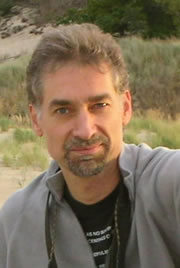Acoustic ecology and ethical listening

Wind harp (Photo by Martin D, Wikimedia Commons)
This article is an abridged version of a piece originally published April 28, 2014 on the City Creatures blog for the Center for Humans and Nature. Using personal experiences of animal encounters in the urban wilderness as my starting point, I suggest "ethical listening" as the acoustic ecologist’s contribution to the conversation between the sciences and the arts as humanity faces complex and "wicked" choices about the planet’s future. This article also serves as a basic introduction to acoustic ecology.
While I was walking alone in the Amherst College Wildlife Sanctuary last spring, I had a startling encounter. Without warning and from about 20 feet behind me, a dog barked. I turned around, heart pounding and… no dog. No coyote either, nor a wolf or any other creature. Weird. What did I hear? The sound was certainly real enough to startle me. I looked toward the spot from where I thought the sound originated. No one there. I was still alone with the trees. I was in a small clearing amongst tall pine trees. The day was cloudy and gray. The tree canopy was swaying with the wind. That was the only sound: the stately ebb and flow of waves of wind passing through the conifers.
I observed no shadows or movement of birds or small mammals on the ground or above. Then, a minute later, I heard it again. As I turned to face the source of the sound, I could tell it was not at ground-level where I would expect a ghost dog to be, but emanating from above. I looked up and noticed that the tall straight trunks of pines were not all growing perpendicular to the ground. Some trees were partly uprooted and leaning against each other. When the wind velocity and direction was just right, I heard it again. Then I understood. The mysterious sound was a frictional noise at the point of contact between two of the trees, producing a resonant sound with a pitch and timbre that matched that of an animal voice.
With this ghostly intrusion demystified, I remember being struck by how marvelous it was that the tree’s bark could actually "bark." I usually avoid anthropomorphizing non-human phenomena, but I can affirm that the woods really do produce uncanny sounds that lie within the vocal range of animals and humans, creating a "voice of the forest."
I share this simple story to highlight the importance of listening and how an awareness of sound can transform one’s relationship to place, and my own interest in unusual sounds. I also think my sonic misidentification and correction serves as an example — one among many — of how aural experiences can be difficult to translate into words. These experiences elude language and often remain unarticulated and therefore underappreciated.
If we are to find a way out of the current impasse, learning how to listen and developing an ethic of listening may be one way resolve it. Listening is particularly relevant to understanding the lives of other animals. Most wild birds and mammals instinctually avoid human presence. Depending on sight alone is most often ineffective at understanding the natural world, until you open your ears and use them to open your mind. When the robins nest around my Chicago home in May and the Canada geese fly over in October, listening to them reminds me that each species has a special way of voicing needs and desires. I am a part of their acoustic worlds, both making and listening to the sounds of this place.
Some say that acoustic ecology places a negative emphasis on noise in urban environments. In fact, it is concerned with improving the quality of the sonic environment, or soundscape, by re-sensitizing hearing and listening faculties both on the individual and the social level. This approach was pioneered in the late 1960s by the Canadian composer, educator and founder of the World Soundscape Project (WSP), R. Murray Schafer. He realized that it was better to set aside moralizing about noise pollution in order to objectively study all aspects of the soundscape.
Schafer founded the World Soundscape Project in 1971. His team of researchers studied and published several books on soundscapes. Schafer coined many terms to help make acoustic phenomena comprehensible. This new field united social, artistic, and scientific concerns of the acoustic environment, establishing a new kind of ecological awareness.
Prior to the WSP, sound had been relegated to special concerns of musician and engineers. Schafer’s The Tuning of the World: The Soundscape inspired a global movement and interest in soundscapes from a broad range of disciplines and engaged public action too. Schafer launched a new field of "acoustic design," that he provocatively described as "practical repair work" as well as "utopian excursions."
These interests prompted me to ask: What might define a "listening ethic"? How might such an ethic apply particularly to understanding the relationship between humans and all other forms of life?
In an attempt to gain some clarity about these questions, I have begun to keep a list of listening 15 qualities that would support a listening ethic. My list is meant to be playful, and to suggest different ways of listening and acting in the world. For example, open listening might be a simple, non-judgmental attitude, similar to peripheral listening or listening without constructing a meaning from what is alien or opaque. Balanced listening: if you make aesthetic value judgments about the sounds you like or dislike, are you being fair, and what criteria are you applying?
Wondering about what lies at the core of acoustic ecology leads me to ask: What might define a "listening ethic"? How might such an ethic apply particularly to understanding the relationship between humans and all other forms of life?
In 2009, I asked Bernie Krause to write a vision statement for the World Listening Project. He immediately wrote back with this statement:
"A few remaining societies in our vast world know how to listen. It is an inherent part of their existence. One in which the received soundscapes of the forests, high plains, deserts, mountains and coastal regions combine seamlessly with the visual, olfactory and tactile senses. In some tropical regions dependence on acoustic perception supersedes that of all the others. Natural soundscapes serve as inspiration for their song and dance. It heals them physically and spiritually. Western society bases most of what it hears, or what it knows on the visual. We actually hear what we see. The World Listening Project aims to transform that perception in our otherwise urban-centric and abstracted lives. At a time when we are facing not only a silent spring, but a silent summer, fall, and winter as well, it is clear that where a picture is worth a thousand words, a soundscape may soon be worth a thousand pictures."
Kraus’s notion that "a soundscape may soon be worth a thousand pictures" is worthy of deep consideration. The turn of phrase is informed by a key tenet of Schafer’s; a rejoinder to privileging visual over aural sensation and knowledge.
Ironically, I have given you nothing to listen to. Or have I? Try to just listen, if you can. Now. Sounds are all around. What do you hear? The near, the distant, he barely audible… the "bark" of two trees? This practice is one to take to the city streets, the alleys and the pocket parks, as well as the woods. There are new worlds awaiting active listeners.
World Listening Day is an annual event held on July 18 (R. Murray Schafer's birthday) to observe and celebrate our listening practices and our soundscapes. Find more information here >


